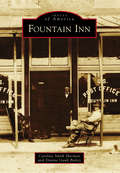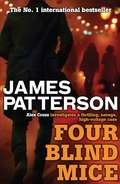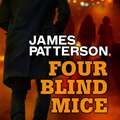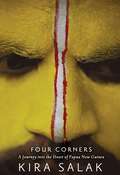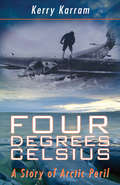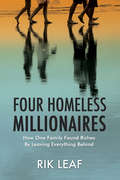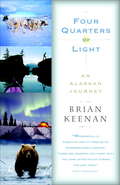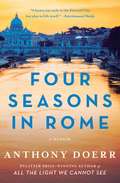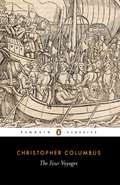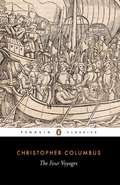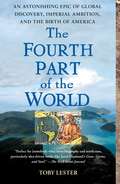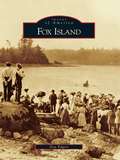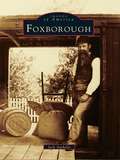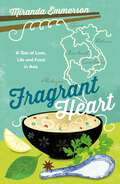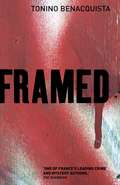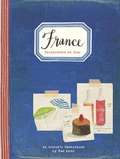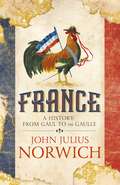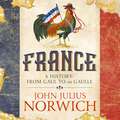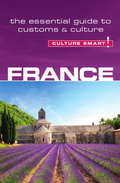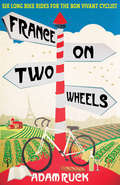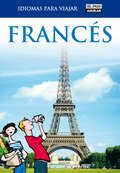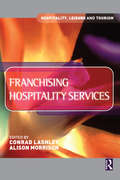- Table View
- List View
Fountain Inn (Images of America)
by Caroline Smith Sherman Dianne Gault BaileyBefore there was an inn and a fountain, the present town of Fountain Inn was half Indian Territory bisected by the “Old Indian Boundary Line.” It was established in 1766 by a treaty made between Old Hop, the head of the Cherokees, and Gov. James Glen of the province of South Carolina. The Cherokees used this area—a region of dense forests, canebrakes, and springs of water—for hunting deer, turkeys, panthers, bears, wolves, wildcats, and even buffalo. Only a few settlers had moved to the territory prior to the Revolutionary War. The Fairview Presbyterian Church community was not settled until 1786. Around 1830, a stagecoach stop was established where there was not only an inn but also a spring of water that gushed two feet in the air like a fountain. In time, the stop became known as Fountain Inn. After the War Between the States, Noah Cannon, a resident of the Greer area, bought up huge tracts of land, and so began the village that was chartered in 1886.
Four Blind Mice (Alex Cross #8)
by James PattersonAlex Cross is preparing to resign from the Washington Police Force. He's enjoying the feeling; not least because the Mastermind is now in prison. And Alex has met a woman, Jamilla Hughes, and he is talking about the future. Then John Sampson shows up at the house, desperate for Alex's help. Three young military wives have been brutally killed during a 'girls' night out' and Sampson's friend, a master sergeant at the army base, stands accused.Uncovering evidence of a series of suspicious murder convictions, Alex and Sampson are determined to infiltrate the closed world of the military. But what is the army trying to hide? And do the mysterious symbols daubed on the house of the accused mean that there are more sinister forces at work?
Four Blind Mice (Alex Cross #8)
by James PattersonAlex Cross is preparing to resign from the Washington Police Force. He's enjoying the feeling; not least because the Mastermind is now in prison. And Alex has met a woman, Jamilla Hughes, and he is talking about the future. Then John Sampson shows up at the house, desperate for Alex's help. Three young military wives have been brutally killed during a 'girls' night out' and Sampson's friend, a master sergeant at the army base, stands accused.Uncovering evidence of a series of suspicious murder convictions, Alex and Sampson are determined to infiltrate the closed world of the military. But what is the army trying to hide? And do the mysterious symbols daubed on the house of the accused mean that there are more sinister forces at work?(P)2012 Headline Digital
Four Corners: A Journey into the Heart of Papua New Guinea
by Kira SalakFollowing the route taken by British explorer Ivan Champion in 1927, and amid breathtaking landscapes and wildlife, Salak traveled across this remote Pacific island-often called the last frontier of adventure travel-by dugout canoe and on foot. Along the way, she stayed in a village where cannibals m was still practiced behind the backs of the missionaries, met the leader of the OPM-the separatist guerrilla movement opposing the Indonesian occupation of Western New Guinea-and undertook an epic trek through the jungle. The New York Times said "Kira Salak is tough, a real-life Lara Croft. " And Edward Marriott, proclaimed Four Corners to be "A travel book that transcends the genre. It is, like all the best travel narratives, a resonant interior journey, and offers wisdom for our times. "
Four Degrees Celsius: A Story of Arctic Peril
by Kerry KarramA dramatic story of the rescue of eight men on a prospecting mission in the Arctic that covers a period of four suspenseful months in the fall of 1929. This true story began in August 1929. A group of eight prospectors, led by C.D.H. MacAlpine of the Dominion Explorers, flew into the Arctic in search of mineral wealth. Grossly underequipped, the expedition ran out of fuel and was stranded above the Arctic Circle. Within days, Western Canada Airways sent a rescue team headed by Captain Andy Cruickshank, in what was to become the most extensive aviation search in Canadian history.The searchers encountered trouble: turbulent weather, forced landings, and plane crashes. The prospectors were also struggling, as they waited edgily for freeze-up and the anticipated crossing to Cambridge Bay. While Cruickshank and his team were trying to reconstruct a damaged aircraft, MacAlpine and his men were forced to run more than 112 kilometres on barely frozen ice to arrive at Cambridge Bay, where they still awaited rescue.
Four Homeless Millionaires
by Rik LeafIn the throes of a global recession, Rik and Zara Leaf sold their house and spent a year traveling around the world with their son Zion, and daughter Riel, investing their life savings in a laugh out loud adventure of a lifetime. The family filmed horror movies in Canada, ate mafia-made pizza in Germany, got caught sneaking onto a Hollywood set in Hawaii, survived a feral dog attack in Malaysia and dorsal fins emerging from the surf as they swam off the Australian coast. The thought of abandoning conventional wisdom and getting away with it was too exciting to pass up. Of course, the decision to really 'go for it' involved lots of anxious 'what ifs' and 'are we out of our frigging minds?' Throughout the year they produced a videos series called, "Where in the World are Zion & Riel?" QR codes linked to these videos are included in the book, creating an amazing interactive reading experience.
Four Quarters Of Light
by Brian KeenanBrian Keenan's fascination with Alaska began as a small boy choosing his first library book in a Belfast school. The book was Jack London's wondrousCall of the Wild. And it has permeated Keenan's life ever since. A short visit to Fairbanks several years ago was enough to seal his connection with the place and he resolved to return. Last year he did so with a head full of questions about its inspiring landscape and heart informed with his own love of the desolate and barren places of the world. In the course of a journey that takes him through four geographical quarters from snowmelt in May to snowfall in September, he discovers a land as fantastical as a fairytale but whose vastness has a very peculiar type of allure . . . From the Trade Paperback edition.
Four Seasons in Rome: On Twins, Insomnia, and the Biggest Funeral in the History of the World
by Anthony DoerrFrom the author of the acclaimed Pulitzer Prize-winning #1 New York Times bestseller All the Light We Cannot See, a "dazzling" (Azar Nafisi, author of Reading Lolita in Tehran) memoir about art and adventures in Rome.Anthony Doerr has received many awards--from the New York Public Library, the National Endowment for the Arts, and the American Library Association. Then came the Rome Prize, one of the most prestigious awards from the American Academy of Arts and Letters, and with it a stipend and a writing studio in Rome for a year. Doerr learned of the award the day he and his wife returned from the hospital with newborn twins. Exquisitely observed, Four Seasons in Rome describes Doerr's varied adventures in one of the most enchanting cities in the world. He reads Pliny, Dante, and Keats -- the chroniclers of Rome who came before him--and visits the piazzas, temples, and ancient cisterns they describe. He attends the vigil of a dying Pope John Paul II and takes his twins to the Pantheon in December to wait for snow to fall through the oculus. He and his family are embraced by the butchers, grocers, and bakers of the neighborhood, whose clamor of stories and idiosyncratic child-rearing advice is as compelling as the city itself. This intimate and revelatory book is a celebration of Rome, a wondrous look at new parenthood, and a fascinating story of a writer's craft--the process by which he transforms what he sees and experiences into sentences.
The Four Voyages of Christopher Columbus
by Christopher ColumbusNo gamble in history has been more momentous than the landfall of Columbus's ship the Santa Maria in the Americas in 1492 - an event that paved the way for the conquest of a 'New World'. The accounts collected here provide a vivid narrative of his voyages throughout the Caribbean and finally to the mainland of Central America, although he still believed he had reached Asia. Columbus himself is revealed as a fascinating and contradictory figure, fluctuating from awed enthusiasm to paranoia and eccentric geographical speculation. Prey to petty quarrels with his officers, his pious desire to bring Christian civilization to 'savages' matched by his rapacity for gold, Columbus was nonetheless an explorer and seaman of staggering vision and achievement.
The Four Voyages of Christopher Columbus
by Christopher Columbus J. M. CohenNo gamble in history has been more momentous than the landfall of Columbus's ship the Santa Maria in the Americas in 1492 - an event that paved the way for the conquest of a 'New World'. The accounts collected here provide a vivid narrative of his voyages throughout the Caribbean and finally to the mainland of Central America, although he still believed he had reached Asia. Columbus himself is revealed as a fascinating and contradictory figure, fluctuating from awed enthusiasm to paranoia and eccentric geographical speculation. Prey to petty quarrels with his officers, his pious desire to bring Christian civilization to 'savages' matched by his rapacity for gold, Columbus was nonetheless an explorer and seaman of staggering vision and achievement.
The Fourth Part of the World: The Race to the Ends of the Earth, and the Epic Story of the Map That Gave America Its Name
by Toby Lester"Old maps lead you to strange and unexpected places, and none does so more ineluctably than the subject of this book: the giant, beguiling Waldseemüller world map of 1507." So begins this remarkable story of the map that gave America its name. For millennia Europeans believed that the world consisted of three parts: Europe, Africa, and Asia. They drew the three continents in countless shapes and sizes on their maps, but occasionally they hinted at the existence of a "fourth part of the world," a mysterious, inaccessible place, separated from the rest by a vast expanse of ocean. It was a land of myth -- until 1507, that is, when Martin Waldseemüller and Matthias Ringmann, two obscure scholars working in the mountains of eastern France, made it real. Columbus had died the year before convinced that he had sailed to Asia, but Waldseemüller and Ringmann, after reading about the Atlantic discoveries of Columbus's contemporary Amerigo Vespucci, came to a startling conclusion: Vespucci had reached the fourth part of the world. To celebrate his achievement, Waldseemüller and Ringmann printed a huge map, for the first time showing the New World surrounded by water and distinct from Asia, and in Vespucci's honor they gave this New World a name: America. The Fourth Part of the World is the story behind that map, a thrilling saga of geographical and intellectual exploration, full of outsize thinkers and voyages. Taking a kaleidoscopic approach, Toby Lester traces the origins of our modern worldview. His narrative sweeps across continents and centuries, zeroing in on different portions of the map to reveal strands of ancient legend, Biblical prophecy, classical learning, medieval exploration, imperial ambitions, and more. In Lester's telling the map comes alive: Marco Polo and the early Christian missionaries trek across Central Asia and China; Europe's early humanists travel to monastic libraries to recover ancient texts; Portuguese merchants round up the first West African slaves; Christopher Columbus and Amerigo Vespucci make their epic voyages of discovery; and finally, vitally, Nicholas Copernicus makes an appearance, deducing from the new geography shown on the Waldseemüller map that the earth could not lie at the center of the cosmos. The map literally altered humanity's worldview. One thousand copies of the map were printed, yet only one remains. Discovered accidentally in 1901 in the library of a German castle it was bought in 2003 for the unprecedented sum of $10 million by the Library of Congress, where it is now on permanent public display. The Fourth Part of the World is the story of that map: the dazzling story of the geographical and intellectual journeys that have helped us decipher our world.
Fox Island
by Don EdgersFox Island has had as wide a variety of names as inhabitants over its long and diverse history. The island was named for American lieutenant John L. Fox, who was with the 1841 Wilkes Expedition. However, it was first known as Bu Teu by the Native Americans who used the island for burials and potlatches, and it was later named Rosario by the Spanish in the 1770s. It served as a temporary Native American reservation after the Indian War of 1856, and later supported a large dogfish processing business and, from 1884 to 1910, a brick-manufacturing company. The island's 1890s community of Sylvan contained a school, a store, a dock, a vacation lodge, and a waterfront church. In 1954, a bridge replaced the ferry to Fox Island. Today the U.S. Navy has an acoustic laboratory on the island, and two large church buildings have been built. Perhaps the most famous resident of the island was Washington's first female governor, Dixy Lee Ray.
Foxborough
by Jack AutheletThis delightful new photographic history of Foxborough presents an affectionate and lively tribute to the town in its heyday. Well-known local historian Jack Authelet has pored through the archives of the Foxborough Historical Commission to select over two hundred vintage images of the town and its people. Combined with an informative text, these outstanding pictures present a revealing social commentary on life in Foxborough from the mid-nineteenth century to the town's sesquicentennial celebration in 1928. Foxborough came of age during the industrial era and this fascinating period is expertly documented here. With photographs of the straw hat factories that made Foxborough famous, as well as images of the people who allowed them to prosper, Mr. Authelet takes his readers on an exciting journey through Foxborough's rich heritage. Readers will gain a tremendous insight into the evolution of Foxborough as a community and also learn of high and low points in the town's development, from monumental civic improvements to the devastating destruction of lives and jobs in natural disasters.
Fragrant Heart: A Tale of Love, Life and Food in South-East Asia
by Miranda EmmersonMiranda and her partner set off for one last big adventure before settling down. They chose to travel through South-East Asia. Asian flu, falling off boats and the general chaos of a life abroad challenged them at every step, yet they fell in love with the culture and culinary delights of China, Vietnam, Cambodia, Thailand and Malaysia.
Fragrant Heart: A Tale of Love, Life and Food in South-East Asia
by Miranda EmmersonMiranda and her partner set off for one last big adventure before settling down. They chose to travel through South-East Asia. Asian flu, falling off boats and the general chaos of a life abroad challenged them at every step, yet they fell in love with the culture and culinary delights of China, Vietnam, Cambodia, Thailand and Malaysia.
Framed
by Tonino Benacquista Adriana HunterAntoine, a fanatic billiards player, is asked to watch over a Paris art gallery. When he scuffles with a thief a statue falls and severs his right hand. His maverick investigation leads to the discovery of a series of gruesome killings. Soon Antoine finds himself the prime suspect in the murder of a gallery owner. A game of billiards decides the outcome of this satirical tale which brilliantly captures the world of modern art and the parasites that infest it. After being, in turn, a museum night-watchman, and a train guard on the Paris-Rome line, Tonino Benacquista is now a highly successful author of fiction and film scripts.
France: Inspiration du Jour
by Rae DunnBrimming with joie de vivre, France provides a glimpse into the gorgeous sketchbooks that artist Rae Dunn compiles during her annual sojourns in Paris, Provence, and the French Riviera. Colors, tastes, and smells come to life with each turn of the page, as Dunn's charming watercolor sketches and dreamy photographs beautifully depict the cityscapes, landscapes, foods, and pastimes that epitomize the romance of France. Additionally, hand-lettered notes reveal Dunn's inspirations as an artist. Francophiles, armchair travelers, and art lovers alike will rejoice in this thoughtful celebration of this beloved region's myriad everyday pleasures.
France: A History: from Gaul to de Gaulle
by John Julius Norwich'For his final book, the late Norwich tackled the dauntingly vast subject of two millennia of French history with admirable lightness and urbanity . . . his comic footnotes deserve a review of their own' DAILY TELEGRAPHI can still feel, as if it were yesterday, the excitement of my first Channel crossing (as a child of nearly 7) in September 1936; the regiment of porters, smelling asphyxiatingly of garlic in their blue-green blousons; the raucous sound all around me of spoken French; the immense fields of Normandy strangely devoid of hedges; then the Gare du Nord at twilight, the policemen with their képis and their little snow-white batons; and my first sight of the Eiffel Tower . . . This book is written in the belief that the average English-speaking man or woman has remarkably little knowledge of French history. We may know a bit about Napoleon or Joan of Arc or Louis XIV, but for most of us that's about it. In my own three schools we were taught only about the battles we won: Crécy and Poitiers, Agincourt and Waterloo. The rest was silence. So here is my attempt to fill in the blanks . . .John Julius Norwich's last book is the book he always wanted to write: the extremely colourful story of the country he loves best. From frowning Roman generals and belligerent Gallic chieftains, to Charlemagne (hated by generations of French children taught that he invented schools) through Marie Antoinette and the storming of the Bastille to Vichy, the Resistance and beyond, FRANCE is packed with heroes and villains, adventures and battles, romance and revolution. Full of memorable stories and racy anecdotes, this is the perfect introduction to the country that has inspired the rest of the world to live, dress, eat -- and love better.
France: A History: from Gaul to de Gaulle
by John Julius NorwichA witty history of 2000 years of French history from legendary popular historian John Julius NorwichI can still feel, as if it were yesterday, the excitement of my first Channel crossing (as a child of nearly 7) in September 1936; the regiment of porters, smelling asphyxiatingly of garlic in their blue-green blousons; the raucous sound all around me of spoken French; the immense fields of Normandy strangely devoid of hedges; then the Gare du Nord at twilight, the policemen with their képis and their little snow-white batons; and my first sight of the Eiffel Tower...This book is written in the belief that the average English-speaking man or woman has remarkably little knowledge of French history. We may know a bit about Napoleon or Joan of Arc or Louis XIV, but for most of us that's about it. In my own three schools we were taught only about the battles we won: Crécy and Poitiers, Agincourt and Waterloo. The rest was silence. So here is my attempt to fill in the blanks...John Julius Norwich (at 88) has finally written the book he always wanted to write, the extremely colourful story of the country he loves best. From frowning Roman generals and belligerent Gallic chieftains, to Charlemagne (hated by generations of French children taught that he invented schools) through Marie Antoinette and the storming of the Bastille to Vichy, the Resistance and beyond, FRANCE is packed with heroes and villains, adventures and battles, romance and revolution. Full of memorable stories and racy anecdotes, this is the perfect introduction to the country that has inspired the rest of the world to live, dress, eat -- and love better.(P)2018 Hodder & Stoughton Limited
France - Culture Smart!
by Barry TomalinCulture Smart! provides essential information on attitudes, beliefs and behavior in different countries, ensuring that you arrive at your destination aware of basic manners, common courtesies, and sensitive issues. These concise guides tell you what to expect, how to behave, and how to establish a rapport with your hosts. This inside knowledge will enable you to steer clear of embarrassing gaffes and mistakes, feel confident in unfamiliar situations, and develop trust, friendships, and successful business relationships.Culture Smart! offers illuminating insights into the culture and society of a particular country. It will help you to turn your visit-whether on business or for pleasure-into a memorable and enriching experience. Contents include* customs, values, and traditions* historical, religious, and political background* life at home* leisure, social, and cultural life* eating and drinking* do's, don'ts, and taboos* business practices* communication, spoken and unspoken"Culture Smart has come to the rescue of hapless travellers." Sunday Times Travel"... the perfect introduction to the weird, wonderful and downright odd quirks and customs of various countries." Global Travel"...full of fascinating-as well as common-sense-tips to help you avoid embarrassing faux pas." Observer"...as useful as they are entertaining." Easyjet Magazine"...offer glimpses into the psyche of a faraway world." New York Times
France in Mind: An Anthology
by Alice Leccese PowersIn her third literary Baedeker, Alice Leccese Powers-editor of Italy in Mind and Ireland in Mind-explores France through the senses and sensibilities of thirty-three British and American authors.The food and the people, the culture and viniculture, the architecture and the expatriates, the pleasures (and frustrations) of France are described by intrepid travelers who also happen to be brilliant essayists, poets, and novelists. From Gertrude Stein's Paris to Ezra Pound's Pyrenees; from Tobias Smollett, who grumbled, to Peter Mayle, who settled in; and from Edith Wharton on falling in love to David Sedaris on falling over French grammar-here is France in all its splendor in the words of some of the best and most entertaining writers in the English language. Henry Adams * James Baldwin * Elizabeth Bishop * Mary Blume * James Fenimore Cooper * Charles Dickens * Lawrence Durrell * Lawrence Ferlinghetti * M. F. K. Fisher * F. Scott Fitzgerald * Janet Flanner * Adam Gopnik * Joanne Harris * Ernest Hemingway * Washington Irving * Henry James * Thomas Jefferson * Stanley Karnow * Peter Mayle * Mary McCarthy * Jan Morris * Ezra Pound * David Sedaris * Tobias Smollett * Gertrude Stein * Robert Louis Stevenson * Paul Theroux * Gillian Tindall * Calvin Trillin * Mark Twain * Edith Wharton * Richard Wilbur * William Carlos WilliamsFrom the Trade Paperback edition.
France on Two Wheels: Six Long Bike Rides For The Bon Vivant Cyclist
by Adam RuckBoth a practical companion and a story of exploration and rediscovery, France on Two Wheels offers detailed descriptions of useful routes, stop-off points and watering-holes, along with detours into subjects as varied as wine, windmills, Wodehouse, and beer. It is vivid proof that the only way to experience the French countryside is on a bike.Adding insight to anecdote, this book is packed with practical tips: on rail travel with a bicycle, mending a puncture in French, and the best stopovers along the route - small hotels, B&Bs and chateaux, every one "a cultural treasure worth celebrating".
France on Two Wheels: Six Long Bike Rides For The Bon Vivant Cyclist
by Adam RuckBoth a practical companion and a story of exploration and rediscovery, France on Two Wheels offers detailed descriptions of useful routes, stop-off points and watering-holes, along with detours into subjects as varied as wine, windmills, Wodehouse, and beer. It is vivid proof that the only way to experience the French countryside is on a bike.Adding insight to anecdote, this book is packed with practical tips: on rail travel with a bicycle, mending a puncture in French, and the best stopovers along the route - small hotels, B&Bs and chateaux, every one "a cultural treasure worth celebrating".
Francés (Idiomas para viajar #Volumen)
by El País-AguilarLas guías de idiomas que rompen barreras lingüísticas Idiomas para viajar. Francés ofrece ahora unos contenidos mucho más amplios y completos. Cada guía recoge todo lo que se necesita para desenvolverse durante el viaje: una guía de pronunciación, un resumen gramatical y un manual básico del idioma como introducción a todos los bloques temáticos pensados para resolver situaciones según avanza el viaje (llegada, desplazamientos, alojamiento, restaurantes, ocio, compras, salud, emergencias...). Todos los capítulos tienen, además de introducciones prácticas del país, un vocabulario imprescindible y expresiones habituales, con sus correspondientes transcripciones. La guía concluye con un nuevo diccionario bilingüe, que contiene todas las palabras de uso habitual en la comunicación diaria.
Franchising Hospitality Services (Hospitality, Leisure, And Tourism Ser.)
by Conrad Lashley Alison Morrison'Franchising in the Hospitality Industry' provides an overview of the issues, debates and challenges associated with business franchising. In two parts, this text firstly looks at the issues from both an academic and practitioner perspective. The second part looks more closely at service sector groups in the hospitality industry, such as hotels, leisure and catering using national and international examples and illustrations. These demonstrate how the theories and debates discussed in the first part, are tackled in real life situations. Examples used are from well known companies such as McDonalds, Baskin Robbins, Burger King, Choice Hotels, Holiday Inn, Domino Pizza, Pierre Victoire amongst others.
